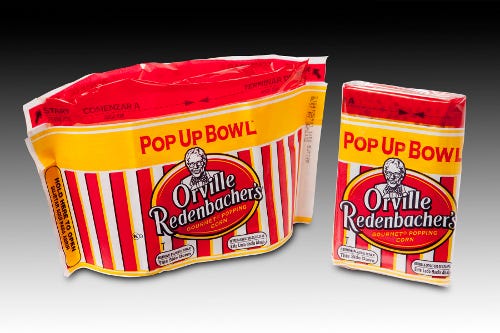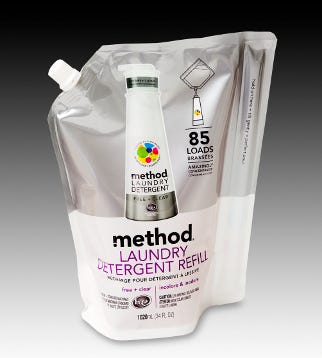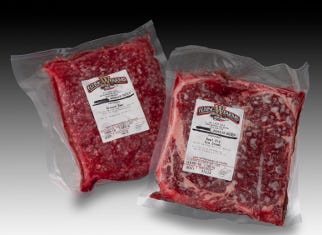Flexible packs finish first
Last year may have been rocky as far as the global economy was concerned. Some businesses are still shaky. But innovation in flexible packaging was steady and strong. Here's proof: A whopping 26 packages have earned recognition in the 2012 Flexible Packaging Achievement Awards from the Flexible Packaging Assn.
These outstanding packages won 32 Achievement Awards within one or more categories including: Packaging Excellence; Printing Achievement; Technical Innovation; and Environmental & Sustainability Achievement.
Judges of this year's competition were Michael Richmond, PhD, co-founder, Packaging & Technology Integrated Solutions (PTIS); Larry Ahleman, master faculty specialist, Western Michigan University; and yours truly. I don't know that I've ever seen a group of flexible packages function as well as this year's winners. They not only looked good, they opened and poured and sat up and resealed with ease.
The Highest Achievement and Gold Award winners are described here in detail. Click here for short summaries of the Silver Award recipients.
Flexible Packaging Assn., 410-694-0800.
www.flexpack.org

Orville Popcorn Bowl
Side-opening bag becomes convenient eat-from bowl
ConAgra's Pop Up Bowl for Orville Redenbacher's popcorn won the Highest Achievement Award, which is given to a Gold Award winning package the judges deem as most significant in advancing flexible packaging. It actually won two Gold Awards, for Packaging Excellence and Technical Innovation.
An improvement over the traditional microwave bag which opens from the end, the Pop Up Bowl opens along the entire side, transforming the bag into an easy reach-in/eat-from container that means no dirty bowl for the consumer to wash. This stable, stand-up package also makes it easier to share the popcorn, say when families are sitting on the couch during movie night.
The package, which ConAgra and its Phoenix Packaging division describe as "the most complex lamination ever produced for high-volume microwave popcorn packages," runs on modified existing form/fill/seal machines at typical high speeds. The structure is monolayer PET, inline corona-treated on both sides, heavy paper strips, a susceptor patch, inline laser scoring, tear tape and custom-developed water-based adhesives.
To create the new side opening, ConAgra used PET film for the bag's side gusset. The film is laser scored and then covered with a PET-based pressure-sensitive tear tape from Payne. This protects the package integrity during storage and shipping, yet creates a clean opening when the film is pulled off after the popcorn is popped.
Critical to the functionality of the package and safety for the consumer, a patent-pending steam venting system is formed during the package-making process by punching a vent feature into the rollstock. Specially formulated water-based adhesive is sealed around the vent to prevent the oil from leaking, but lets go as pressure builds up during cooking to safely release the steam.
The Maple Grove, MN, plant where the package is laminated and filled isn't set up to handle solvent-based printing systems, so ConAgra selected a dry-bond adhesive for the susceptor patch.
Payne, 800-849-0633.
www.payne-worldwide.com
Phoenix Packaging Div., ConAgra Foods, 763-657-8950.
www.conagrafoods.com

Icelandic Grouper Fillets
Matte/gloss technique creates a fish package that's way out of its competitors' depthIf you don't feel compelled to reach out and pick up the pepper on the Icelandic Grouper Fillet pouch, it's only because the photo doesn't do it justice. Winning a Gold Award for Printing Achievement, Flex-Pack combines vibrant colors, high-resolution rotogravure printing and registered matte varnish, which gives the pouch an irresistible, pick-me-up, three-dimensional look.
In four short weeks, the folks at Icelandic and Flex-Pack created a stellar result that started from the customer's creative and the thought that a matte finish might give them the look they needed. Presented with packaging graphics that featured a high-quality photo, Flex-Pack suggested adding depth to the image by registering a matte finish so it wouldn't cover certain areas, namely the fillets, the peppers and the parsley. Keeping those sections glossy (a natural characteristic of the film) helps them stand out from the matte background and highlights details from the photograph.
Mark Coleman, Flex-Pack president, offers, "For our customers, we try to take the time to scrutinize designs and figure out best way to produce it for the best look possible."
Flex-Pack used a proprietary structure of oriented polyester adhesive laminated to a metallocene grade of polyethylene. This gives the package a lower melt index ceiling to withstand the lower temperatures of a freezer environment. Measuring 4.5 mils, the film performs in temperatures from -20 to 100 deg F.
The film is gravure printed in one pass on a 10-station press using nine colors-CMYK and five spot colors for the logo, type on the back, the black UPC code and more-plus the matte finish. Coleman says the company uses certain printing techniques to pump up the volume, for example accentuating the colors behind the pepper and the fish fillets. One trick for adding depth was to keep the onion muted (with the matte finish) so the glossy pepper on top really pops.
The layout of the printed film was designed for the pouch style, a reclosable header bag, and for Flex-Pack's pouch-making machine, which Coleman respectfully declined to identify. The front and back panels are printed head-to-head for a total film width of 31.5 in. During pouch manufacturing, the film is folded in half and a standard press-to-close zipper from Zip-Pak is sealed to the web. Side seams are a standard 10mm, but the graphics don't bleed all the way to the edge. A 2mm clear space at each edge acts as a transition zone during printing.
Flex-Pack, 513-561-1559.
www.flex-pack.com
Zip-Pak, 800-488-6973.
www.zippak.com

Blue Bones
Two webs, two-stage printing create one outstanding pouchThe 12-oz flexible box pouch from Plastic Packaging Technologies LLC for Blue Bones Small Natural Dental Chew Bones for dogs won Gold Awards in three categories: Packaging Excellence, Printing Achievement and Technical Innovation.
The Blue Buffalo Co. created a crisp, clean, fun design, with graphics that wrap around the four-side-sealed pouch, showcased in a mix of sophisticated matte varnish and shiny gloss to highlight the brand name, product type and health benefits of the product. A clear glossy window in the shape of a buffalo galloping though an open field lets consumers see the quality of the product inside. In addition to offering a billboard on store shelves, the square box-pouch format stacks easily and cubes out for efficient shipping.
Among the achievements of this package are tight register of two-stage printing and the accurate marriage of two webs to create the pouch.
Using a combination of printing methods, Plastic Packaging Technologies prints the front, bottom and back panels on one polyester web and the side gussets on a separate polyester web. The structure of both webs is the same: varnish/48-ga PET/ink/adhesive/4-mil EVOH coex. A solventless lamination marries the PE print web to the EVOH sealant layer. The film is then flexographically printed on a Paper Converting Machine Co. (PCMC) Infiniti-NT central-impression gearless press in two passes. The first is to reverse print in 8 colors—4 process colors (CMYK) plus blue, orange and two decks of white. The second pass is to add the surface matte varnish in register with the print. Both reverse printing and the matte varnish protect the package from scuffs. Why not do it all in-line? Alison Tuso, Plastic Packaging Technologies' director of technical services and product support, says, "We don't have a turning bar and the ability to print on both sides of the web in one pass."
Once the two webs are printed, Plastic Packaging Technologies creates the pouches on a Totani SG-6 pouch-making machine. Registration is difficult to maintain, but critical. Tuso explains how they are able to hold it: "With the use of an electronic eye that fires on one of the design elements."
Another nice touch: Side gussets are terminated below the pouch opening for a clean zipper placement across the top of the pouch.
Paper Converting Machine Co. (PCMC), 920-494-5601.
www.pcmc.com
Plastic Packaging Technologies LLC, 913-287-3383.
www.plaspack.com
Totani, 920-632-7319.
www.totani.co.jp/en/

Microwavable One Size Fits All
One pack instead of many simplifies inventory, lowers costsWinning a Gold Award for Technical Innovation, the Microwavable "One Size Fits All" packaging from Berry Plastics Corp. simplifies a food processor's packaging material inventory while lowering packaging costs and raising production efficiencies. The design allows food packers to package various food products for microwave steam cooking in any package format (pillow, gusseted and 3-side-sealed pouches) and size (from 5 to 28 oz) using only one roll spec.
The packaging has a proprietary mechanical venting system. The vents are in a continuous repeat pattern in the film's machine direction so that sufficient venting will occur at any package length.
Berry Plastics Corp., 812-306-2000.
www.berryplastics.com

Amcor Interior Tinted
Fewer false rejects save product/packaging wasteWinning a Gold Award for Technical Innovation, Formpack blister material from Amcor Flexibles Europe and Americas has a colored surface that allows high-speed pharmaceutical packaging lines to keep running at top efficiency with fewer false rejects. How? Amcor found a way to embed tint into the aluminum laminate film of coldform blisters to provide a better-contrasting background for automatic inspection systems.
Existing coldform films often make it hard for the vision equipment to "see" if a blister cavity is properly filled or not with certain colored tablets. When in doubt, the system kicks out the whole package. But a false reject causes a dip in product output and wasted materials.
Formpack can be tinted-or printed with a brand message-in custom colors, making it easier for vision systems to register a correct fill/no-fill. Mark Morgan, Amcor's product manager, pharmaceutical and personal care, says, "The interface of the PVC (sealant) and the foil is tinted, which can be done with various printing and laminating processes, as it is not meant to be design specific."
Because the tinted surface of the tinted/ printed Formpack does not impact the product contact surface, customers don't have to redo their packaging material stability testing. This simplifies product launches to speed up time to market.
At least three major pharmaceutical companies are using tinted Formpack for prescription drugs, but none were willing to go on record as a customer or to say how many fewer false rejects they have acheived. That improvement, Morgan says, will vary depending on the type of tablets/capsules being package, as well as the type of the blister equipment being used.
Amcor Flexibles Europe and Americas, 847-362-9000.
www.amcor.com

Method Pouch
‘Rigidized' pouch adds stability, easy pouring to detergent refillsRegular Packaging Digest readers may be experiencing déjà vu. "Haven't we seen this before?" You sure did. Details on the design and development of this award-winning package were published in PD's October 2011 issue (it was our cover story).
In a nutshell, Method altered the typical Doyen-style spouted stand-up pouch for its detergent refills in two ways to make it easy to pour with one hand and to improve store merchandising:
1. A narrow vertical pocket along the right side holds a rigid spine that creates a handle for consumers to grab and improves the pouring experience;
2. A slight taper to the outer edges of the pouch's bottom, along with the spine, help it stand up better when it's filled and the bottom gusset opens.
Method developed the pouch with help from flexible packaging consultant and distributor Innovative Packaging Solutions (IPS). IPS coordinated the pouch's manufacture through Hong Kong-based Mayor Packaging, a Bemis Co.
Structure of the laminated pouch is (outer to inner layer) PET/ink/adhesive/ nylon/adhesive/LLDPE. The outer PET layer is reverse rotogravure printed in nine colors (4-color process plus white and then four spot colors that change depending on the fragrance). The nylon layer provides needed puncture resistance.
The PE-based spine is hollow (to reduce the amount of material used), sourced from a supplier overseas and elliptically shaped. The flattened spine feels more comfortable to consumers than a rounded one and presents a better looking profile on the package's front panel. The 205mm spine is tapered slightly, vertically, and has an angle at the smaller end to make it easier to insert into the pouch's formed pocket.
Compared to Method's primary laundry detergent package, this refill pouch represents an 80 percent savings in plastic, water and energy. It won a Gold Award for Technical Innovation.
Innovative Packaging Solutions Inc. (IPS), 951-693-5580.
www.ipspack.com
Mayor Packaging, +852 2342 5194.
www.mayor.com.hk

FreshCase for Red Meat
Vacuum-packed meat blooms fresh, with 10x shelf lifeMuch longer shelf life and less product waste are two key benefits of FreshCase packaging films for fresh red meat from Curwood Inc.
FreshCase films—which allow red meats to bloom to a fresh red color in an oxygen-free vacuum package—offer up to 10 times the shelf life and 75 percent less waste than store-wrapped meats. They also reduce packaging material up to 75 percent compared to other case-ready formats. For these reasons, the development earned a Gold Award in Environmental & Sustainability Achievement.
The meat achieves its red color in the vacuum packs because a controlled amount of sodium nitrate (NaNO2) is extruded into the product contact layer of the film and interacts with the meat, stabilizing the natural red bloom that consumers associate with "fresh." Shelf life is extended from three to five days to more than 30 days for whole muscle beef and ground meats.
Because the vacuum pack doesn't need the headspace that is required for modified atmosphere packs, it takes up significantly less space in transit and display cases. According to Curwood, the amount of corrugated needed to box up the meat is reduced by up to 50 percent compared to MAP master packs or tray-and-lid MAP formats.
Films can be as thin as 2 mil or as thick as 6 to 8 mil.
Curwood Inc., A Bemis Co., 920-527-7300.
www.curwood.com

Heinz Dip & Squeeze
Dual dual-function ketchup pack serves foodservice and retail customersWinning a Gold Award for Packaging Excellence, the Heinz Dip & Squeeze ketchup package gives consumers two ways of enjoying the condiment anywhere and at any occasion: they can dip into it or squeeze it out.
For the initial foodservice launch, Heinz chose a clear APET extrusion lamination for the cupstock that's flexible enough so consumers can tear off the top and squeeze it to dispense the ketchup like a typical packet—and without it bursting or cracking in transit. But it's rigid enough to support the condiment if consumers choose to peel back the foil lid and dip fries or nuggets into the cup.
This material provides a six-month shelf life, all that's needed for the quick-turn environment of fast-food restaurants. But when Heinz followed the Dip & Squeeze institutional success with a retail version, it needed a boost. It doubled the shelf life, achieving 12 months, with an ultra high-barrier semi-rigid film for the forming cup. The material, Encompass from Curwood Inc., is a polyester that incorporates an oxygen scavenger laminated to a high-barrier sealant web. Once the scavenger reaches its capacity, the barrier film maintains a high oxygen transmission rate for the rest of the product life.
Curwood Inc., A Bemis Co., 920-527-7300.
www.curwood.com

Ganador QuadSeal Sack
Premium print helps graphics pop on rich black backdropPrintpack Inc. won a Gold Award for Printing Achievement for its work on the premade bag for Ganador pet food sold in Latin America (Ganador means "winner" in Spanish). In 2011, brand owner Malta Texo de Mexico S.A. de C.V. redesigned its 10kg sack (about 22 lbs) to maintain its position against a leading competitor who had recently changed its package to a matte finish.
Keeping its existing recognizable graphics, Malta Texo added a matte finish to 100 percent of the package. It also gained merchandise-friendly gussets by switching to Printpack's QuadSeal technology. Branding is visible whether the package is displayed vertically or horizontally. The square-format sack provides stacking stability on pallets/ store displays and the higher coefficient of friction of the matte finish helps prevent the bags from slipping around. The QuadSeal technology is particularly useful for heavy products because it reinforces all seals in the gussets.
The bag is reversed printed on a flexo press in CMYK, white and gold. Alondra Quintanar, Printpack's marketing coordinator, explains how they achieved such a rich black background. "The rich black was achieved by developing a specific combination of ink densities and formulation, material opacity and prepress work," Quintanar says.
Printpack Inc., 404-460-7000.
www.printpack.com
.
About the Author(s)
You May Also Like




